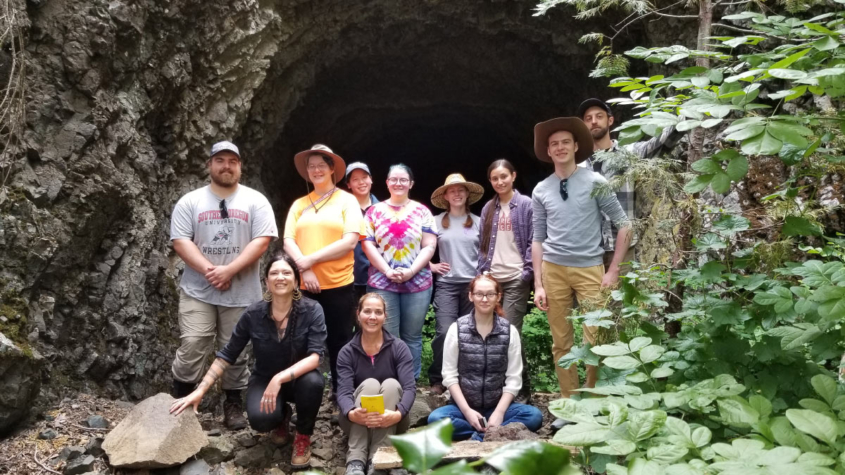SOULA wins Oregon Heritage Excellence Award for Chinese immigrant research
(Ashland, Ore.) — The Southern Oregon University Laboratory of Anthropology (SOULA) has won a 2020 Oregon Heritage Excellence Award for its work on the Oregon Chinese Diaspora Project. Students worked with faculty on the project as part of a Sociology and Anthropology (SOAN) summer archaeological field school in 2019.
“The (Oregon Heritage Excellence Award) recipients represent the extraordinary efforts to preserve Oregon’s heritage,” said Beth Dehn, coordinator for the Oregon Heritage Commission. “They also serve as models for others on how to develop new ideas, approaches and innovations.”
The Oregon Chinese Diaspora Project is one of only 10 projects to receive the award. The grassroots archaeology partnership of federal, state and local agencies examined the Chinese diaspora – or dispersed population – in Oregon, and challenged stereotypes that have been historically assigned to the immigrants.
The project is led by Chelsea Rose of SOU Laboratory of Anthropology, who partners with archaeologists from state and federal agencies on archaeological sites across Oregon.
The ongoing project has involved digging, interpreting and touring nine archaeological sites where Chinese immigrants worked and lived; and searching historical records such as censuses, community records and data from the Kam Wah Chung Museum in John Day. Research findings have been publicized through lectures, tours, theses, digital “story maps” and will be presented in an upcoming volume of the Oregon Historical Society’s quarterly journal. Local involvement with volunteer projects has been encouraged through the cultural heritage program Passport in Time and other public archaeological events.
“It is exciting to see how far this project has come, and how much can be accomplished when agencies work together toward a common goal,” Rose said.
SOULA started the partnership with the Malheur National Forest, and it has since expanded to include Oregon State Parks, the Medford District of the U.S. Bureau of Land Management, the Oregon Historical Society, and other local and regional organizations.
The lead editors of the Chinese in Northwest American Research Committee – Chuimei Ho and Bennet Bronson – wrote one of three letters recommending the OCDP for the Oregon Heritage Excellence Award.
“Very few heritage efforts in other places have been as effective and innovative,” the letter from Ho and Bronson said. “Nothing like it currently exists in California or elsewhere in the Pacific Northwest. The OCDP’s research subject is vast, still largely untouched, and of great importance to all Chinese Americans.”
The historic population of Chinese immigrants in rural Oregon was high, but there are few descendant communities because of anti-Chinese violence and the federal Chinese Exclusion Act of 1882. The OCDP offers Oregonians a deeper sense of their shared heritage by discovering and publicizing Chinese achievements.
Don Hann, project co-director with the Malheur National Forest, has used innovative Light Detection and Ranging (LIDAR) technology to document historical Chinese mining sites. LIDAR, which sends a laser pulse through the surface of the ground, has allowed OCDP archaeologists to map over 1,000 acres of mining complexes hidden in the forest within an accuracy of 10 inches. The new maps highlight a system of dams, reservoirs and ditches that provided water for mining.
These complicated water systems reveal a picture of 19th century Chinese immigrants as entrepreneurs who had experience organizing gold mining operations in foreign countries.
SOU students participated in the OCDP last year by taking the class SOAN 375. The four-credit, four-week course – the archaeological field school – introduced methods of excavating, mapping, recovering and recording artifacts from prehistoric or historic sites.
“It was an incredible project for SOU staff and students to be a part of, and we are continuing to work and expand our research across the state,” Rose said.
She and other members of the SOULA staff have also worked on the Cangdong Village Project, a Stanford-led transnational research project looking into the five-county area that was home to most Chinese Immigrants during the 19th century. SOULA partnered with the Hannon Library and PAR Environmental in 2018 to create the Chinese Material Culture Collection – a digital archive of artifacts commonly found on 19th and 20th century Chinese archaeological sites in the American West.
Story by Blair Selph, SOU Marketing and Communications student writer
-SOU-



